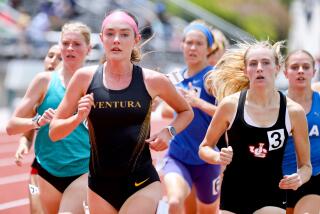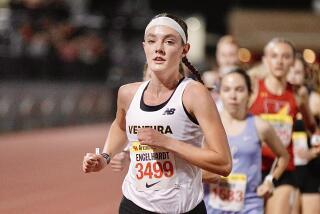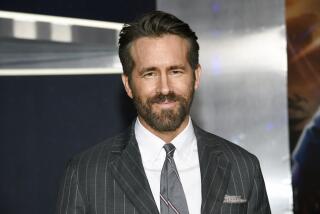Reynolds Runs Beyond Pain : UCLA Distance Runner Is Back on Track After Four Years of Fighting Injuries
- Share via
Whatever happened to Eric Reynolds, who was considered by some to be the nation’s top high school distance runner in 1983?
That’s a painful question, especially for Reynolds. But first, how good was he?
At Camarillo High, Reynolds twice was the Southern Section 4-A champion at 3,200 meters. He also won the 1982 4-A cross-country title as well as the Kinney national championships.
During his senior track season, Reynolds won the state title at 3,200 meters and was timed in 8 minutes, 44 seconds for two miles, the fifth-fastest time ever by a high school runner, while competing in the 1983 UCLA/Pepsi Invitational.
Bob Larsen, UCLA track and cross-country coach, recruited Reynolds thinking that the youngster had greatness in him. In 1983, Larsen said that Reynolds was “clear-cut the best high school distance runner in the nation.”
Herb Potter, his coach at Camarillo, said that Reynolds “is really one of a kind. I mean he’s the kind of kid that comes along once in a lifetime if you’re lucky.”
There was talk of breaking records, of competing in the ’84 Olympics.
But that was before Reynolds, now a fifth-year senior at UCLA, ran into a series of injuries that have prevented him from completing a full track or cross-country season in the past four years.
He has been so plagued by injuries, he said, that “I haven’t been able to consistently perform at all. I’ve never been able to train enough and get into good shape to race effectively.”
In his freshman year at UCLA, he said, he was bothered by a “shin-splint syndrome that was kind of chronic, that would never go away. It was kind of a structural problem. I have real high arches, and my heels pronate, or roll in, excessively.”
After his freshman year, surgeons operated on his left shin and scraped away scar tissue. He redshirted the following year.
In preparing to return to competition in 1985, he injured a knee while running at a training camp in Yosemite. He said that he probably should have stopped running for a few weeks to let the knee heal, but he continued to run. Though he had another operation to remove inflamed tissue in his knee, he was troubled by pain throughout the cross-country and track seasons.
To correct his foot-strike problem, he said, he experimented with different kinds of orthotics, corrective devices worn inside shoes and commonly used by distance runners.
“But it took a lot of experimentation to find the right set of orthotics,” he said. And a lot of learning through pain.
“In four years, rarely a day goes by that I can go out and run without pain. I’m a fifth-year senior and I haven’t been able to complete one season.”
Reynolds is the captain of the cross-country team this season and hopes to complete his final year of college. But even though he is running, and running well for one with his medical history, pain has not been a stranger.
Recently he has been bothered by a sore quadricep muscle in his leg. Though he placed 27th at a Cal Poly San Luis Obispo invitational cross-country meet Oct. 17, Larsen said that “up until the last few minutes I thought he shouldn’t run.”
Larsen said that Reynolds performed well considering his condition and that he would be ready for the Pacific 10 Championships at Stanford Nov. 2.
Reynolds has had better showings in cross-country this season. He finished 13th at the Fresno State invitational and 15th at the Stanford invitational.
Larsen said that it hasn’t been easy for Reynolds to settle for less than being first.
“It’s difficult for a person who has enjoyed the very highest achievement at one point in his life to then turn around and have to work very hard just to be competitive with runners that he knows he would easily beat if he could work out as much as they did,” Larsen said.
He said that Reynolds has been lucky to run 30 to 35 miles a week in training on the rare occasions when he has not been bothered by injuries, but that good distance runners regularly do 70 miles a week or more in their workouts.
“I really respect him for hanging in there and continuing to be as competitive as he possibly can be,” Larsen said. “This fall, finally now, he’s had his best races by far and his longest uninterrupted workout base.
“I’m real optimistic, if his legs can stay healthy through the end of the year, that he will be pushing some of the best runners at the Pac-10 meet and at the Nov. 14 NCAA District 8 Championships at Fresno.
“I feel that he could definitely have a very good track season in the spring if he can continue to train now without major interruptions,” Larsen added.
Major Interruptions could be a nickname for Reynolds, so it is not surprising when he says that he is taking the short view on distance running these days, that he approaches running one step at a time.
“My first goal is to be healthy for a whole year, which is definitely the key to specific performance goals,” he said. “To run well you have to train.”
If he stays healthy and can train sufficiently, he hopes to qualify for the NCAA cross-country championships, which will be held Nov. 23 in Charlottesville, Va.
After that--again, if he remains in good shape and trains enough--he hopes to qualify for the NCAA track championships next spring.
If he is unable to compete against the best, he will continue to run, he said, “whether it’s on a high level or not.”
It would not be surprising if Reynolds had given up running altogether. After all, he said that there were many times in his years at UCLA when college “was no fun at all, not just because I wasn’t winning, but the whole social aspect, also. Any athlete at UCLA definitely derives self-confidence and satisfaction from competing well.”
Reynolds also feels that his history of injuries has hurt his confidence when he has felt well enough to run. Consequently, he has reduced his goals.
“When I go into a race now I’m not really thinking of victory but of a good solid performance over last year,” he said.
Many people have asked Reynolds if he has become discouraged at UCLA because he has been unable to live up to the promise he showed in high school. Many have asked him if he had thought about quitting.
“Yeah, realistically I have,” he said, “but I felt even more that I would rather come back and compete well than quit.”
More to Read
Go beyond the scoreboard
Get the latest on L.A.'s teams in the daily Sports Report newsletter.
You may occasionally receive promotional content from the Los Angeles Times.






